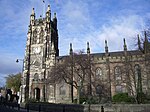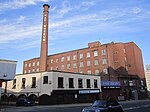Staircase House
| Staircase House | |
|---|---|
 The main entrance to Staircase House from the market place | |
| General information | |
| Architectural style | Medieval |
| Town or city | Stockport, Cheshire, now in Greater Manchester |
| Country | England |
| Coordinates | 53°24′44″N 2°09′15″W / 53.4123°N 2.154221°W |
| Completed | c1460 |
| Designations | |
Listed Building – Grade II* | |
| Official name | Staircase House |
| Designated | 27 April 1992 |
| Reference no. | 1356855 |
Staircase House (30/30a Market Place), also known as Stockport Museum, is a Grade II* listed medieval building dating from around 1460 situated in Stockport, historically in Cheshire, now within Greater Manchester, England.[1] The house is famous for its rare Jacobean cage newel staircase. An audio guide recounts the full history of the house.[2]
History
[edit]15th to 19th century
[edit]Staircase House, (grid reference SJ897906), is in its origins a cruck timber building, with its earliest known surviving timbers dating from 1459 to 1460 on the basis of dendrochronology.[3] Very little is known of the property's early history, though it is thought that it may have been the home of William Dodge who, in 1483, was the Mayor of Stockport.
The first residents of whom there is certainty were the Shallcross family who owned the House from 1605 to 1730. Members of the landed gentry, with their seat just across the county boundary, in Derbyshire, it was they who in 1618 installed the distinctive Jacobean cage newel staircase, from which the house takes its modern name.[4] The staircase has some unusual features, such as the carving covering much of the woodwork.
The characteristic of a cage newel staircase, after which it is named, is that each of its newel posts extends throughout the full height of the staircase, the four posts and the banisters thus forming a stairwell which is not fully enclosed, but rather contained within a cage-like structure. In fact, at Staircase House, at some date before the first surviving descriptions of the staircase in the 19th century, the newel posts were each sawn through, just below the stringer board and just above the handrail. That may have been done as a response to changing tastes, or possibly to overcome the practical difficulties of moving large objects, such as furniture, about the house.
20th century
[edit]In its later years in private ownership, the House was used partly as the Staircase Café until 1989, and into the 1990s as storage for Gardner's Green Grocery and Fruit stall which stood in the market, immediately in front of the House itself.
The House, including the staircase, was painstaking restored using traditional materials, tools and techniques, following a major fire in 1995,[5] the second of two arson attacks on the semi-derelict building. The restoration was undertaken by Stockport Metropolitan Borough Council, after having compulsorily purchased the property, following a long and persistent campaign to save it by a local conservation group, the Stockport Heritage Trust, beginning in 1987.[6]
The Trust, local volunteers, argued that the House was a unique survival and should be preserved and, on that basis, it dissuaded the council from demolishing the building as a dangerous structure as had been previously proposed.[7] Stockport Heritage Trust financed tree-ring dating establishing the date of the earliest remaining parts of the House as 1460.[8] They commissioned the first measured architectural survey of the building and were successful in pressing for it to be upgraded officially from its Grade II designation in 1975 to a Grade II* listed building in 1992.[9]
Stockport Museum
[edit]Now open to the public, Staircase House offers a unique glimpse into the life of medieval and renaissance Stockport, the origins of the town, its status as a borough and a market town, and the subsequent stages of the House's development until the 1940s, when it was last used as a private dwelling.
It forms part of Stockport Museum, with a collection that includes objects and displays from the Palaeolithic period, the Mellor Iron Age hilltop settlement, through medieval times, the local Victorian era textile industry, the impact of World War I, Strawberry Studios, and the history of sport in the town.[10][11]
See also
[edit]- Hat Works, the UK's only dedicated hatting museum, located in Stockport
- Stockport Air Raid Shelters, now part of Stockport's museum service
- Grade II* listed buildings in Greater Manchester
- Listed buildings in Stockport
References
[edit]- ^ "Shawcross Fold: Overview of the regeneration project". Stockport.gov.uk. 19 February 2021.
- ^ "About Staircase House". Stockport.gov.uk. 22 December 2022.
- ^ Mike Nevell (1997). The Archaeology of Trafford. Trafford Metropolitan Borough with University of Manchester Archaeological Unit. pp. 71, 75. ISBN 1-870695-25-9.
- ^ "Shawcross Fold: Staircase House". Stockport.gov.uk. 19 February 2021.
- ^ Warden, Sarah (21 January 2013). "Amazing rebirth of Staircase House". Manchester Evening News. Retrieved 3 August 2023.
- ^ "Staircase House". woodawards.com. Wood Awards. Retrieved 3 August 2023.
- ^ "Museum tribute to unsung heroes". Manchester Evening News. 18 January 2013. Retrieved 3 August 2023.
- ^ "Tree-Ring Analysis of Timbers from Staircase House, (30A & 31 Market Place), Stockport, Greater Manchester". historicengland.org.uk. Historic England. 4 February 2003. Retrieved 3 August 2023.
- ^ "Staircase House". historicengland.org.uk. Historic England. Retrieved 3 August 2023.
- ^ "About Stockport Museum". stockport.gov.uk. Stockport Metropolitan Borough Council. Retrieved 3 August 2023.
- ^ "Stockport Museum". artuk.org. Art UK. Retrieved 3 August 2023.
External links
[edit]- Buildings and structures in Stockport
- Grade II* listed buildings in Greater Manchester
- Houses in Greater Manchester
- Historic house museums in Greater Manchester
- Museums in Greater Manchester
- History museums in Greater Manchester
- Tourist attractions in the Metropolitan Borough of Stockport
- Culture in Stockport






